The AMD Trinity Review (A10-4600M): A New Hope
by Jarred Walton on May 15, 2012 12:00 AM ESTAMD Trinity Gaming Performance
After the 3DMark results, you might be wondering if Intel has finally caught up to AMD in terms of integrated graphics performance. The answer is…yes and no. Depending on the game, there are times where a fast Ivy Bridge CPU with HD 4000 will actually beat out Trinity; there are also times where Intel’s IGP really struggles to keep pace. The good news is that at least everyone is now onboard the DX11 bandwagon, and compatibility with games has improved yet again for Intel. Here are our “Value” benchmark results for seven recent games; we’ll have more information in a moment.

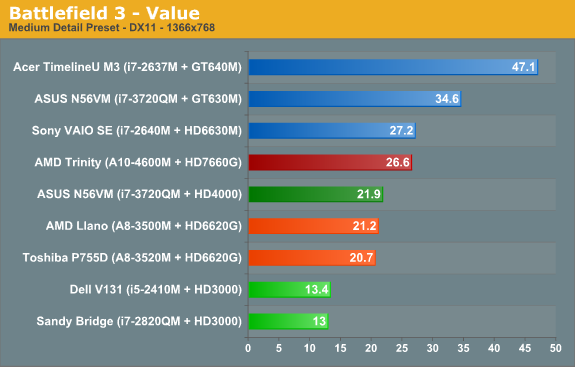
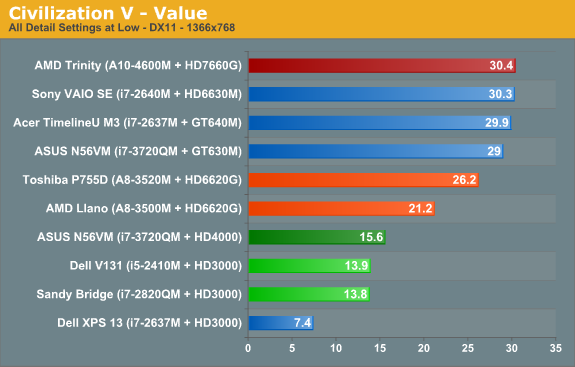

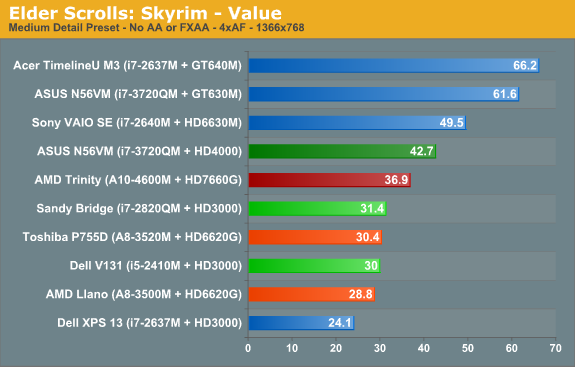
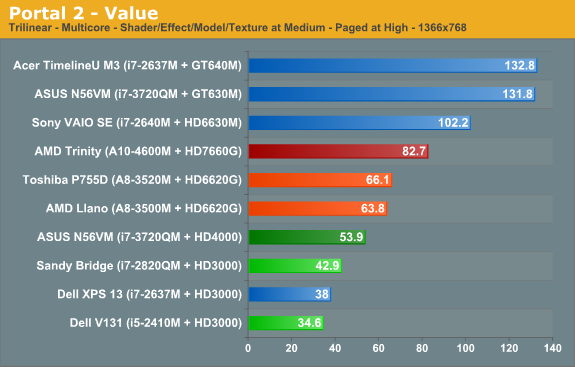
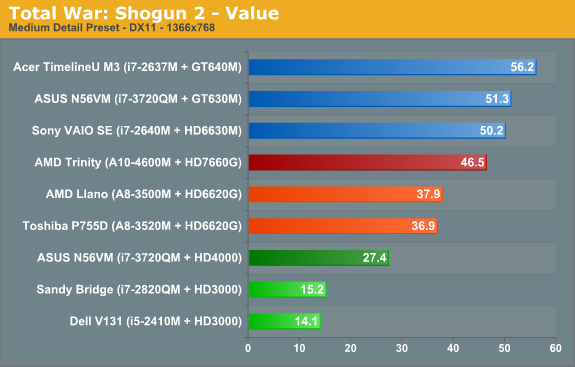
Out of our seven test titles, AMD’s Trinity leads any other IGP in four titles by a large margin. The other three titles actually have Ivy Bridge slightly ahead of Trinity, but the gaps aren’t nearly as big. Overall, the average performance across the seven games at our Value (medium) settings has AMD’s Trinity A10-4600M leading Intel’s i7-3720QM by 21%, and if we look at quad-core Sandy Bridge with HD 3000 (i7-2820QM) Trinity is 72% faster. Trinity is also around 20% faster than 35W Llano on average.
Let’s expand our gaming suite just a bit to see if things change, though. Just like we did with Ivy Bridge, we ran the eight games in our previous benchmark suite at medium detail settings. We can then compare performance across a wider 15 title selection to see how Trinity matches up against HD 4000, HD 3000, and HD 6620G (Llano). We’ll start with the bottom (HD 3000/Sandy Bridge) and move up.
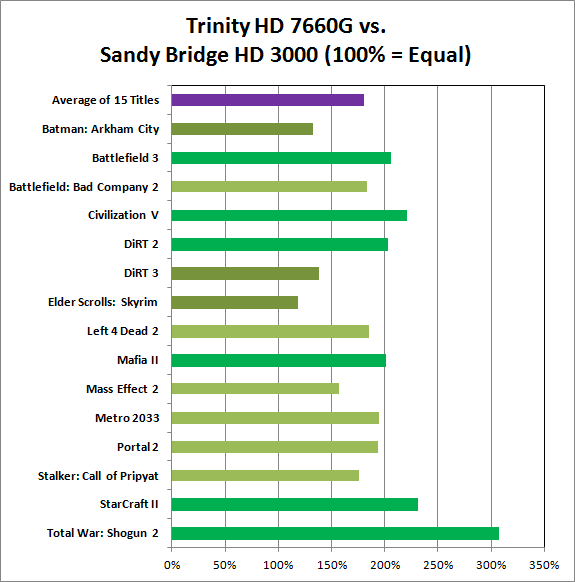
Llano’s HD 6620G was already faster than HD 3000, and Trinity’s HD 7660G is faster than Llano, so the Sandy Bridge gaming matchup is a landslide victory in AMD’s favor. The closest Intel can get is in the same three titles where Ivy Bridge leads Trinity: Batman: Arkham City, DiRT 3, and Skyrim. Here, however, HD 3000 can’t actually close the gap and HD 6620G is at least 20% faster than HD 3000, with an average performance improvement of nearly 80%.
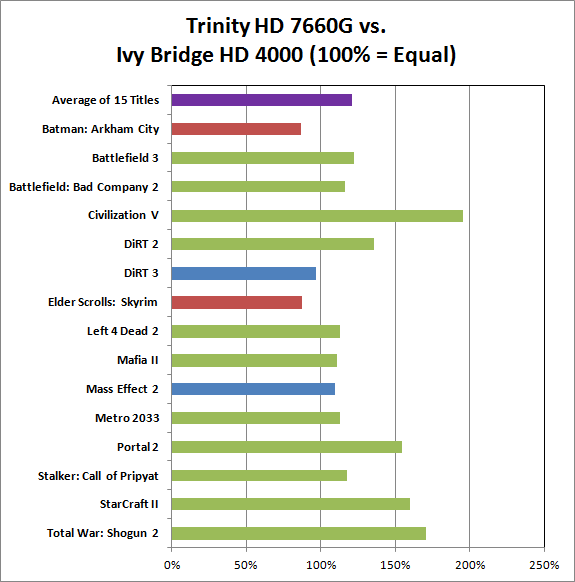
We found that across the same selection of 15 titles, Ivy Bridge and Llano actually ended up “tied”—Intel led in some games, AMD in others, but on average the two IGPs offered similar performance. This chart and the next chart will thus show a similar average increase in performance for Trinity, but the details in specific games are going to be different. Starting with Ivy Bridge and HD 4000, as with our earlier game charts we see there are some titles where Intel leads (Batman and Skyrim), a couple ties (DiRT 3 and Mass Effect 2), and the remainder of the games are faster on Trinity. Mafia II is close to our <10% “tie” range but comes in just above that mark, as do Left 4 Dead 2 and Metro 2033. The biggest gap is Civilization V, where Intel’s various IGPs have never managed good performance; Trinity is nearly twice as fast as Ivy Bridge in that title. Overall, it's a 20% lead for Trinity vs. quad-core Ivy Bridge.
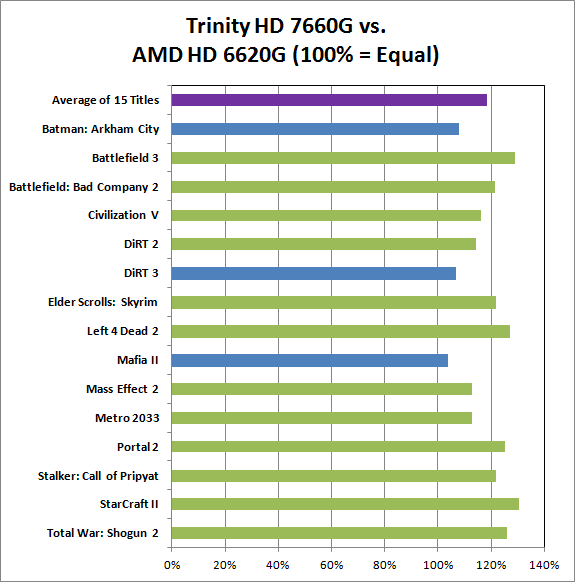
Against Llano, Trinity is universally faster, but the smallest gap is in Mafia II (3%) while the largest gap is in StarCraft II (30%). On average, looking at these games Trinity is only 18% faster than Llano. What’s not entirely clear from the above chart is whether we’re hitting CPU limitations, memory bandwidth limitations (remember that Llano and Trinity share bandwidth with the rest of the system), or perhaps both. At our chosen settings, what is clear is that Trinity’s “up to 56% faster” graphics never make it that high.
We saw 35-45% higher scores in 3DMark 11 and Vantage, which tend to remove the CPU from the equation more than actual games, so our guess would be that if AMD continues with their APU plan they’re going to need to work more on the CPU side of the equation. We also see the same thing looking at the VAIO SE scores in the earlier gaming charts: the HD 6630M scores are 20% faster on average, but much of that appears to come from the faster CPU rather than the GPU.










271 Comments
View All Comments
JarredWalton - Tuesday, May 15, 2012 - link
I think it *needs* to be at $600 to sell, because SNB + GT 540M is already at $600. However, HP has hinted that their sleekbooks with Trinity will start at $600 and $700 for the 15.6" and 14" models, respectively. "Start at" and "comes with a reasonable amount of RAM and an A10 APU" are not the same thing. Until HP actually lists full specs and a price, I have to assume that the $600 price tag for the 15" model is going to be 4GB RAM, 250GB HDD, and an A6-4400 APU. Hopefully I'm wrong, but the fact is we don't know Trinity's real price yet, so in the article I'm referring to the price I think it should be at in order to provide a good value.hechacker1 - Tuesday, May 15, 2012 - link
As most people I assume are coming from the Core 2 Duo style laptops, I would like to see a comparison of trinity with that.I know core i processors are fast, but I don't know if AMD has caught up with Core 2 performance.
tipoo - Tuesday, May 15, 2012 - link
Even with Llano they had caught up, with Trinity the margin will only be larger. Use this to compare whatever you wanthttp://www.anandtech.com/bench/Product/399?vs=62
cosminmcm - Monday, May 21, 2012 - link
How about comparing Llano to a core 2 quad? And at about the same frequency.Here you go:
http://www.anandtech.com/bench/Product/399?vs=50
This Guy - Wednesday, May 16, 2012 - link
Sorry to be rude. I really think you missed the point of this chip.The CPU in Trinity is close to a 17W CPU with a 17W GPU. It performs about the same as an intel 17W chip. It's graphics engine is far better and the CPUs should cost about the same. The only real disadvantage over 17W Sandy Bridge is that in a prototype chasis Trinity uses more power, but a few watts should be shaved on production models.
This means AMD has caught up to Intel again! Yes AMD is going to lose spectacularly when ULV Ivy Bridge comes out and I doubt Trinity is going to scale at higher power but at low power, AMD has caught up!
(Yes I know that Sandy Bridge includes a GPU but if you look at your benchmarks, ULV Intel with a dGPU scores similar to Trinity when transcoding [The only really CPU limited test in this review])
ET - Wednesday, May 16, 2012 - link
Something I just read at The Tech Report: when using MediaEspresso to transcode video, the result of VCE was much smaller than QuickSync or software, yet they didn't notice a difference in quality. I would like to know what your experience was. If that's really the case I'd prefer VCE over other Intel's solution even if it's slower.Riek - Wednesday, May 16, 2012 - link
As far as i know VCE is not yet supported or been made available by AMD.All those tests are due to openCL and not VCE since that part cannot be reached at this point in time. (yes blame AMD for that one, this is already taking 6months and still their is nothing about VCE)
Spunjji - Wednesday, May 16, 2012 - link
You're mistaken, there.Quote from Page 2:
"Trinity borrows Graphics Core Next's Video Codec Engine (VCE) and is actually functional in the hardware/software we have here today. Don't get too excited though; the VCE enabled software we have today won't take advantage of the identical hardware in discrete GCN GPUs"
karasaj - Wednesday, May 16, 2012 - link
When you go to the llano review, the HD4000 gets stomped by Llano's desktop graphics offering. When you look at Trinity, the notebook version of trinity barely beats Llano. Why is it that Intel can practically fit the full power of their IGP (get nearly the same performance from notebooks as from 3770k) but AMD's is drastically weaker?Also - will we see a weaker HD4000 in the dual core/cheaper IVB variants? I think Trinity desktop GPU will stomp on the HD4000 and might actually be a viable budget gaming solution as long as CPU improvements are good enough. We could see it take down quite a bit of the discrete graphics market I think, considering the HD4000 already can do that.
JarredWalton - Wednesday, May 16, 2012 - link
It's an odd move by Intel, perhaps, but I think it makes sense. The mobile Sandy Bridge and Ivy Bridge parts basically get the best IGP Intel makes (HD 3000/4000), and what's more the clocks are just as high and sometimes higher than the desktop parts. Yeah, how's that for crazy? The i7-3720QM laptop chips run HD 4000 at up to 1.25GHz while the desktop i7-3770/K/S/T runs the IGP at up to 1.15GHz. SNB wasn't quite so "bad" with HD 3000, as the 2600K could run HD 3000 at 1.35GHz compared to 1.3GHz on the fastest mobile chips.Anyway, the reason I say it kind of makes sense is that nearly all desktops can easily add a discrete GPU for $50-$100, and it will offer two or even three times the performance of the best IGP right now. On a laptop, you get whatever the laptop comes with and essentially no path to upgrade.
For AMD, if you look at their clocks they have them cranked MUCH higher on desktops. The maximum Llano clocks for mobile chips are 444MHz, but the desktop parts are clocked up to 600MHz. What's even better for desktop is that Llano's GPU could be overclocked even further on many systems -- 800MHz seems to be achievable for many. So basically, AMD lets their GPU really stretch its legs on the desktop, but laptops are far more power/heat constrained. It will be interesting to see what AMD does with desktop Trinity -- I'd think 900MHz GPU core speeds would be doable.